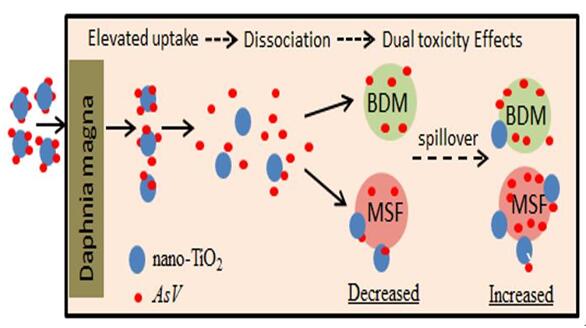Titanium dioxide nanoparticles (nTiO2) are manufactured in large quantity and widely used due to their large surface areas, stability, anti-corrosion and photocatalysis property, etc. The extensive ues of nTiO2 can’t avoid leading human exposures and Environmental disclosure, and then threaten the health of human, animal and even the whole ecosystem. Recently, research articles concerning nTiO2 increase by leaps and bounds. It suggests that the security of nTiO2 is being paid more and more attention. Although the existing research shows that, nTiO2 adsorb metal and organic contaminants by physical adsorption such as electrostatic forces and chemical combination such as chemical bonding to enhance their bioavailability. However, it lacks a systematic study in how the co contaminants distribute and promote potential toxic effects after nTiO2 facilitate the entry of cocontaminants into organisms as a carrier. Urban aquatic environment and ecology research group(Changzhou Yan’s research team), Institute of Urban Environment, Chinese Academy of Sciences, systematically has studied how it influenced arsenate (As(V)) accumulation, distribution, and toxicity in D. magna taking nTiO2 as the research object. The results showed that, nTiO2, as a postive carrier, significantly improved As(V) accumulation in D. magna. As nTiO2 concentrations increased from 2 to 20 mgTi/L, total As increased by a factor of 2.3 to 9.8 compared to the uptake from the dissolved phase. We found that TiO2 and arsenic (As) accumulation in D. magna have significant correlations (at concentrations of 2.0 mgTi/L nTiO2, R = 0.676, P < 0.01; and 20.0 mg-Ti/L nTiO2, R = 0.776, P < 0.01), as determined by laser ablation inductively coupled plasma mass spectrometry(LA-ICP-MS). It also confirmed the carrier role of nTiO2. Moreover, this study found a very interesting phenomenon, that, As(V) toxicity associated with nTiO2 was not in accordance with its accumulation in D. magna. This research attempts to explain this phenomenon from the Angle of the subcellular distribution. Compared to the control, the increased As was mainly distributed in BDM (biologically detoxified metal), but Ti was mainly distributed in MSF (metal-sensitive fractions) with increasing nTiO2 levels. Differences in subcellular distribution demonstrated that adsorbed As(V) carried by nTiO2 could dissociate itself and be transported separately, which results in increased toxicity at higher nTiO2 concentrations(20.0 mg-Ti/L). Decreased As(V) toxicity associated with lower nTiO2 concentrations results from unaffected As levels in MSFs (when compared to the control), where several As components continued to be adsorbed by nTiO2. The result of the study is published in the international famous journal in the field of environmental science. Environmental Science & Technology, 2016, DOI: 10.1021/acs.est.6b01215(Mengting Li, Zhuanxi Luo, Yameng Yan, Zhenhong Wang, Qiaoqiao Chi, Changzhou Yan, and Baoshan Xing. Arsenate accumulation, distribution, and toxicity associated with titanium dioxide nanoparticles in Daphnia magna)。This study was jointly funded by the National Nature Science Foundation of China (41271484, 41401552, and 41301346). 相关链接:http://pubs.acs.org/doi/abs/10.1021/acs.est.6b01215

The schematic how nTiO2 influenced As(V) bioavailability and toxicity in D. magna.